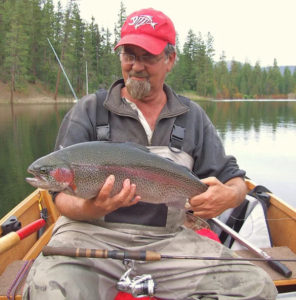Rooster Tails For Early Season Trout
By Bill Herzog, Yakima Baits
from The Fishing Wire

Big trout like Rooster Tails
April means Opening Day for trout anglers. Lakes are starting to warm, trout are becoming active and anglers are there for this exciting time. Choices for taking trout are many: dough baits, spinners, spoons, plugs and good old worms and salmon eggs. All work. But none have the versatility, all around effectiveness and reputation as well known as the Rooster Tail spinner.
Rooster Tails can be cast or trolled. Trolling is an excellent way to cover water and find aggressive trout. The flash of the Rooster Tail blade creates a greater attraction radius than most lures, bringing in more trout to strike. Early season trout frequently hang out in the first 10 feet of water, where it is warmest with the most feed. The weighted body of the Rooster Tail keeps the lure in the perfect depth while trolling, no need to add weight.
When trolling Rooster Tails, try a thin diameter braid with a 6 foot section of 8 pound natural toned mono tied with a Uni knot at the end of the braid to the lure. Even at slow trolling speeds, you may see the vibration and blade spin easily on the rod tip due to the non stretch properties of braid. Rooster Tail blades are tuned to rotate even at the slowest trolling speeds.
Favorite sizes and colors? Well, there are 10 sizes, 100 colors and 135 finishes to choose from. Try the 1/16th, 1/8th, 1/6th and ¼ ounce for the perfect balance of casting/trolling. For trout trolling and casting in lakes, here are some top choices that keep rising to the top of most effective: Red (R), red body/hackle/silver blade; Clown Coachdog (CLCD), olive/yellow/orange body/hackle/silver blade; Fire Tiger (FRT), yellow/olive/red body/hackle/brass blade; Frog (FR), green/olive body/hackle/brass blade; White (WH) white body/hackle/silver blade and Yellow (YL), yellow hackle/body/silver blade. My absolute favorite is the new Cheese Fly (CHFY), with an orange/yellow tail and body, brass blade. Last spring, more trophy sized rainbows, browns, brookies and especially cutthroat fell to that color combo than any other.
Tipping is not just for good service in restaurants, it can be the difference in an interested trout follow into a vicious strike. A small 1 inch piece of nightcrawler or single salmon egg on the treble/single hook on a Rooster Tail makes a great lure unbeatable. No bait, no problem…spritz a pump of Rooster Tail Scent Spray on the lure. Rooster Tail Scent Spray is loaded with amino bite stimulants and UV to really pop visually as well as smell. Best of all the spray will not matte down the attractive movement of the hackle tail.
Best flavors? In this order, but know that each one was flat deadly the last two seasons: Garlic Plus, Trophy Trout and the leader going into the clubhouse Trout Kokanee Magic.
If trolling is not your thing, no problem. Rooster Tails can be cast easily on light line. Position yourself (boat or bank) near where trout may be found and fan cast your Rooster Tail, covering the area. Start your presentations near the surface, then with each “round” of casts, let the lure sink a few seconds more, until bottom is reached or strikes become consistent at a certain depth/area. Retrieve the Rooster Tail just fast enough for a 4 to 6 time “blade thump” per second. To ensure a good blade spin, retrieve the lure quickly at the beginning of the presentation until you feel the “thump” of the rotating blade. Reel ‘till you feel, as they say!
Great sizes/weights for casting are the 1/8ths for shallower water/close to your position; the 1/6th for ideal all around size for distance and depth and the ¼ ounce for breezy conditions or when you have to get the lure down quicker.
A great tip that needs to be put out there is Rooster Tails are not just for trolling or casting/retrieving, they can be jigged also. When trout get finicky- and if you spend any time on the water there is a guarantee there will be times when bites are hard to come by- try this trick. After casting and beginning your retrieve, sharply drop your rod tip approximately six inches, creating a nano second of slack line and allowing the Rooster Tail to drop a foot or so. Many salmonids (trout, salmon) key on falling prey, mimicking a wounded/dead/distressed creature of sorts. This swift, short dropping action can trigger an aggressive grab from a trout that may have been on the fence if it was to bite or not.
Learn more at www.yakimabait.com.